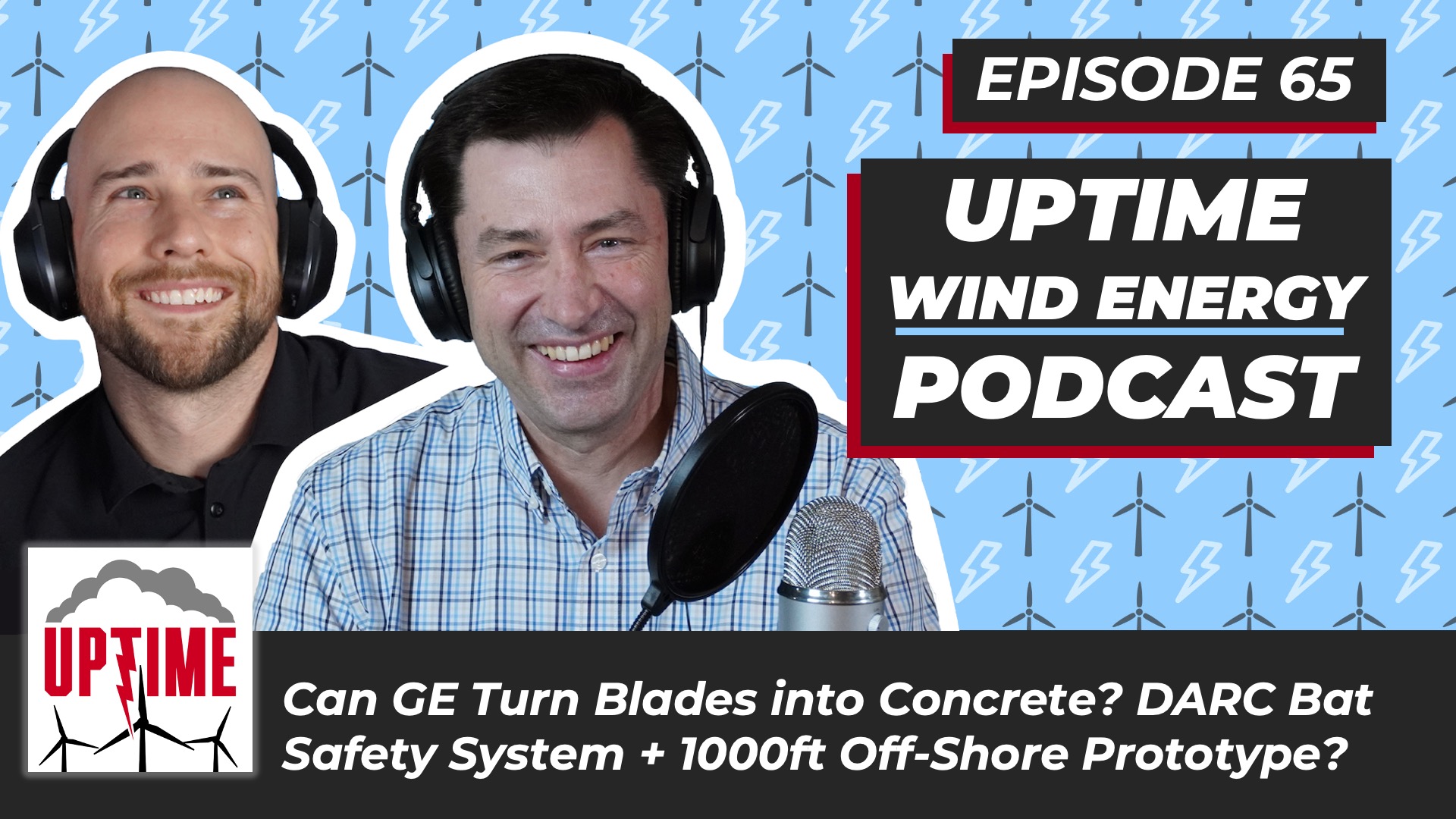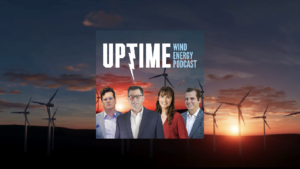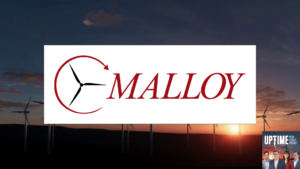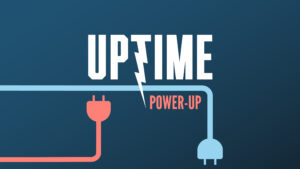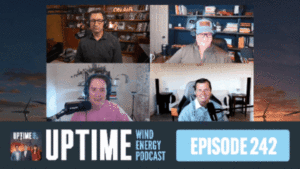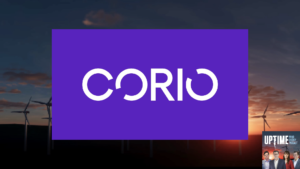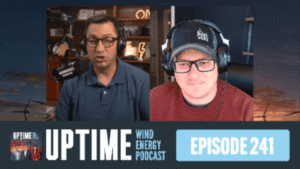GE Announces a partnership with LafargeHolcim to recycle old wind turbine blades into concrete – will it work? Plus, the DARC system vows to protect bats through a smart curtailment system, and we discuss a new 1000ft tall offshore prototype that purports to replace dozens of turbines in one installation.
Sign up now for Uptime Tech News, our weekly email update on all things wind technology. This episode is sponsored by Weather Guard Lightning tech. Learn more about Weather Guard’s StrikeTape Wind Turbine LPS retrofit. Follow the show on Facebook, YouTube, Twitter, Linkedin and visit Weather Guard on the web. Have a question we can answer on the show? Email us!
Podcast: Play in new window | Download
TRANSCRIPT – EP65 – Turbine Blades into Concrete? Bat Protection for Towers Plus 1000ft Offshore Turbine?
0:00
This episode is brought to you by Weather Guard Lightning Tech. At Weather Guard, we make lightning protection easy. If your wind turbines are due for maintenance or repairs, install our StrikeTape retrofit LPS upgrade at the same time. A StrikeTape installation is the quick, easy solution that provides a dramatic long lasting boost to the factory lightning protection system. Forward Thinking wind site owners install StrikeTape today to increase uptime tomorrow. Learn more in the show notes of today’s podcast.
0:37
Welcome back. I’m Allen Hall. I’m Dan Blewett. And this is the uptime podcast where we talk about wind energy engineering, lightning protection and ways to keep your wind turbines running.
0:57
All right, welcome back to the uptime podcast. I’m your co host Dan Blewett. On today’s show, got four really good topics number one we’re gonna talk about GE working with with Lafarge wholesome on winter and blade recycling and mixing some of the, you know shredded up winter and bleeds into cement, which is a really cool idea. We’ll talk about a new tool called dark that’s going to help protect bats while hopefully keeping energy production up for some of these winter minds with their curtailment curtailment solution. We’re gonna talk about this as my favorite thing of the week is the 1000 foot, it looks like a huge box fan. That’s potentially going to be a an offshore solution, this new prototype said to be really, really powerful, and can essentially take all this sort of swept area and put it into one sort of condensed package. And then lastly, we’ll talk a little bit more about these prototypes, a GE floating prototype, and all that stuff. And when before we get going, I want to remind you that you can subscribe to uptime tech news. So if you’re a regular listener of the show listener to the show, number one, thank you. Number two in the show notes whether you’re on YouTube, iTunes, Spotify, you can just check right below there’s a link and if you sign up, you’ll just get an email from us every Thursday saying hey, we got a new episode. Here’s some other great articles who found the web including the stuff that we discussed on the show. So if you want to stay current on what’s happening in the wind industry, definitely sign up for uptime tech news again, link is in the show notes below. So Alan, how are you sir? Let’s get started with GE in cement. So we had, you know, the founder of CO BOD Henrik lon Nielsen on the show and they had a great partnership with GE and Lafarge wholesome. Lafarge was providing the unique,
2:43
you know, concrete cement mixes for their 3d printers, which they’re printing, you know, winter and blade, foundations and towers and all that stuff, actually. So I’ve watched a pretty cool video, they built the first Habitat for Humanity home down Arizona this past week. So a lot of good stuff coming out of the forest wholesome, but they’re teaming up with GE to potentially recycle wind turbine blades. And my big question for you here is,
3:06
as you know, an expert in composites. What does this mean for the strength of cement? I mean, it seems like this is probably a really good type of aggregate to mix into cement would not be Yeah, it is. And there’s been basically chopped fiberglass, and even chopped carbon fiber, which is much more expensive, put into concrete mixes, because it kind of binds everything together. It makes it like a concrete composite. That’s what it does. So there’s there’s an advantage. There’s advantages to that. And it looks like GE has completed for full circle now, the recycling and reuse of wind turbine blades, from grinding them up to then taking them to a cement processing company maker that can also can use it for partially fuel partial for reinforcement. And then 3d printing went by basis. Right, the towers, print the towers. So they have a life cycle. That’s pretty cool. That’s a that’s the first step anybody’s done that that I know of. So it does. So not only you’re using that winter and Blaze, but you’re also making your towers, your next generation of towers stronger, which is a bonus, and probably less expensive because some of that chocolate wind turbine blade takes up raw materials that you would otherwise have to put into the cement mix. thereby making maybe possibly lower cost overall. We’re just yeah, just pretty raw material. Yeah, right. You have your own raw material. Yeah, right. Exactly. So there’s just maybe a lower cost
4:41
reuse that
4:44
does make them at this point. The industry leader in recycling it there’s no one else close right yet. I don’t think Yeah, well, and when we talked about Veolia recently and that they have a solution that they were also partnering with GE so right I
5:00
I don’t know the answer to this, but maybe you know, all three of those companies are maybe collaborating again, I don’t know that for sure. But you know, we know Veolia has the technology to shred these blades, essentially, and to help get them into that recycled wool aggregate kind of form. So you think that maybe they fit into this, this, you know, since GE is obviously working with both companies, so right. It’s good to see these big companies teaming up to do what’s important, because it seems like for a long time, companies weren’t that interested in what happened to their products afterward, after, after they were, you know, they’re done. And of course, that’s still a big problem with, you know, soda pop bottles, and a lot of these consumers single use plastics, they’re still not. So kudos to the wind industry for taking the initiative doing this one. There’s still lots of consumer products that are not that that’s true. But there’s also a financial incentive to do it now. Right, I think that’s what’s going to drive,
5:53
GE and viola, and everybody else to go find out where the wind turbine blades are sitting right now, and get them shredded, right. That’s now there’s an incentive to do that’s a financial incentive to do it. So they’re going to start looking around trying to find those places where blades are stored, maybe even dig up the ones that they’ve already buried, so they can recycle them, which would be just truly fascinating. Because that is foreseeable, it’s very similar to this is probably pre birth of Dan. So BD
6:24
worked before.
6:26
Where we used to have aluminum cans, like if you walk down the street at one point as a kid, there only be like soda cans and crap and garbage. And one of the things they did was incentivize people to recycle aluminum by alumina had value. You can recycle as cans and get paid. And all sudden, all the aluminum cans just disappeared from the street. So it was a financial incentive to recycle them. And it sounds like GE just made a way to to incentivize
6:56
operators, owners of winterplace to recycle them, because you may get paid for them to take them away to grind them, which is better than burying them. That’s for sure. So that’s just really cool. It’s a really cool, yeah, this one that does not predate me, because I definitely, I’m pretty sure as a family, we would like recycle some cans and go get to go to the recycling center.
7:20
I can’t remember how old I was, but I was probably pretty young. So it’s exciting to like, collect 20 cans get $1 when $1 was actually useful back then, when I was a kid, you get a box of macaroni and cheese for 49. So you know, and so not that I was gonna go buy macaroni and cheese, but
7:36
and of course, even maybe like a decade ago, I don’t I don’t know if I’ve seen anyone doing this. But you would see, you know, people on the streets like you’d see homeless, collecting cans like phishing through the trash to get them out. And they would get money that way, which is also a good thing. Obviously a heartbreaking thing. But, you know, people knew like, Hey, this is like, if I’m out here, I can collect this. And this is money a resource for me. I don’t I don’t know if that’s still the case, though. I don’t know that. I’ve seen someone do that. But I certainly noticed that in the past. Maybe that was when I was in Baltimore, you know, more than 15 years ago now for college. Good grief, age, age.
8:11
But yeah, and of course, was at Vestas, who’s found a way to essentially dissolve, it’s not like they’re dissolving their blades and reducing them back into there. Yeah, that was that was, I should have been a chemical process. And the process was you break it back down into its elemental pieces and reuse them
8:30
break down to get the fiber back out, get the resin system back out and reuse the resin system again, that’s a lot different. There’s, there’s a lot of pieces to that, what makes it complicated. And I wonder how much financial incentive there is to do that versus grind it and sell it to another industry?
8:49
Probably you said a grain of salt to another industry, probably GE is pretty good about counting the accounting groups that GE are pretty good about finding out whether the money lives and how to make things work financially. I have a pretty good feeling Geez, work this one out.
9:05
Well, yeah, and you wonder, I mean, I think at this point, it’s good for everything to be an arms race, right? I mean, if there’s three different ways to potentially recycle blades, and everyone starts getting on with the business of doing it, then you’ll figure out like, yeah, the cement thing actually is a lot more economically viable than the, you know, the chemical reduction technique, if that’s what you’d call or, you know, turning them into parts of parts, which we’d see in the past. I think we talked about that over a year ago that some parts over in Europe, were using wind turbine blades chopped up and, you know, as like either art pieces or just sort of just as like a thing, like just sit on into benches, whatever it was, but obviously there’s gonna be so many of them. You can’t put them every every part. Yeah, right. That’s true. In America has a slightly different issue than Europe in terms of wind turbines, because we tend to put wind turbine farms up in groups of 100, Germans and Europeans to do them in groups of three 510. So when
10:00
A Park runs out a service like the United States, there’s a lot of blades. And, and we have
10:08
just because it’s easier, you know, America is a big country. So there’s easy to kind of get them to one from where they need to go
10:18
to get recycled. So there’s a big problem. I think if you’re GE, and you’ve put a lot of wind turbines up in the United States, you know, that’s going to be a big problem, you know, it’s going to be a big problem the next couple of years. So they’ve been obviously been working on it three or four or five years at this point, these things don’t don’t pop out of thin air, there’s been a lot of work and engineering studies and accounting studies and agreements behind the scenes that we haven’t seen. And we’re just now just seeing the very beginning of it. But you know, these agreements have gone on for quite a while, which is really fascinating. It’s been quite so quiet. So GE is not about this for a long time. Yeah. Yeah.
10:56
So moving on, there’s a interesting article from the Office of the role from energy.gov. Talking about company natural powers, da RC system dark,
11:07
trying to just recover energy while protecting bat. So obviously, one way to protect, you know, animals, like whether it’s birds or bats, would be to curtail the wind turbine, so turn them off, and then you know, they’re going to be okay. But obviously, that is a huge power loss. So this dark system has a bunch of sensors, it can, it can tell, I can pick up using microphones, the bats, ultrasonic echolocation calls, which is crazy and super cool. And then it can shut it down in 10 minute increments, which is obviously not going to be a huge power loss. So sounds complicated sounds really interesting sounds also somewhat similar to what the the guys over at ping are doing over in Australia with their
11:51
acoustic monitoring Alan’s a sound like a good solo, it’s one way to address the concern, which is bats getting around turbine blades and the just the preffered pressure differentials around the blades affecting the bats very small, sensitive, body and frame.
12:10
So there has been a lot of discussion about if we detect bats, what’s the easiest thing to do with the easiest thing to do from a safety standpoint is a stop determines. But there has been a lot of discussion about, well past whatever time it gets dark, essentially, when dusk, you managed to shut them off, and then turn them on the next morning, and that that’s a huge power loss, especially if there’s no, no bats around some of the turbans for most of the night.
12:35
So you’re losing a pile of energy that you could otherwise be generating. Whereas if you are detect them locally, and then shut off, turbans for a limited amount of time, until the bats basically leave the area and get back going again, you’re just going to regain a lot of power you otherwise would lose. Remember, it wasn’t an Ohio and wasn’t in Lake Michigan with their tacos? Or is it Lake Erie or there? Were going to shut down the tournament at nighttime, right? I think Lake Erie, which is what you’re trying to trying to deal with is how do you minimize the downtime without affecting the wildlife so much? And seems like a pretty smart way to do it? You know, I guess the it really lies in the details how accurate the system is. And obviously, when they install the system, we’re going to be monitoring to see how well it does. All you need to do is kind of walk around in the morning and see how many bats are on the ground, unfortunately. But that’s the way it’s going to happen. It but yeah, look, it’s better than not having wind energy at all, which is the other alternative. So there’s a good compromise. Yeah, it’s just that.
13:40
Yeah, it’s like a drawbridge approach, right? Like, the bridge is gonna be down and drive Well, most of the day, but you got to lift it up once in a while let ships go through. So that’s a lot better than just like you said, not having a bridge swimming, because there’s too many big boats coming through. Yeah, so that it seems like we have the technology to like I said, I’ve never heard of that before them being able to detect their echolocation calls. But that is super cool. And yeah, that it does and it doesn’t seem like bats are out there for forever. Right? It seems like they’re making the rounds doing their thing, just like a flock of birds like they’re, they’re not just lingering in the sky. So
14:13
yeah, that seems like a good, a good solution. So the big thing that’s out like today because this is my favorite new prototype when I feel like there’s more offshore wind prototypes, like jumping out in the news cycle than ever right now. Like it’s almost it’s not even close to the what’s happening in aerospace with electric vertical takeoff and landing vehicles. But there’s definitely more of these because everyone’s realizing Hey, there’s like we need more often offshore solutions and it’s it can’t all be inside the box with the standard horizontal wind turbine but this wind catching system
14:48
is it looks like to me just I see a huge like white box fan like those cheap $15 fans that you put on when you spend your summer living in an apartment without air conditioning and it’s got a ton of
15:00
Smaller wind turbines in it. So just the cells and obviously the three spoke blades. But this thing is a scale is 1000 feet tall, which is gigantic. And it’s not, you know, it’s on three huge piles. But, I mean, it seems Hey, like that seems interesting. But Alan what what technical problems might you might they encounter? The first one is how you going to support it and what kind of infrastructure you’d have underneath it to support it. Second comes in terms of maintenance, I think hyaena maintain the thing, which is really important, because there’s, there’s all kinds of maintenance on wind turbines all year round, rarely, do you have a six month period where everything’s quiet? So how are you going to maneuver around this large grid? turbans? Note is not discussed. But I think that’s one of the biggest issues is maintenance and repair. How do you do that? and say, You lost one of the blades way up top? Do you got to shut down everything else to get up there and repair it? As a worker? I’m not sure. Yeah, it’s a good question. Yeah. Sure, I want to be around a lot of whirling blades on this superstructure, which would just doesn’t seem practical. You know, it’s one of those engineering things you see, like?
16:15
I don’t think so. But who knows, right? I mean, obviously, they’re gonna have to make small prototypes and try them and see how it scales up, which is the way you do things in engineering is start small, figure out all the details. And it’s just decided whether you can make it in full scale or not. I just think there’s so many little details involved in power generation, particularly wind turbine power generation, that you kind of lose that.
16:43
You lose all you lose the details. You’re thinking on a grand scale, and it’s the details that will kill a project. Just that’s just what happens. Yeah, it seems like a lot of complexity, like, yeah, like you said, and that’s to say, There’s 100 Mini turbines on it. If one is down two, they go fix it. Right, if three is down, do they like what’s the threshold when they have to go? And like, take care of it? Because you’re right, if one in the center is down? I mean, they’ve got to stop the whole thing, conceivably to probably to access it. And that, and of course, they’re like, you know, the intricacies of this? It’s, it’s not disclose, it’s just showing one rendering from one angle. So who knows? But, but yeah, obviously more of a lot of arts is not better than less limit moving cards. But yeah, again, like maybe they designed like, Hey, we could lose 15 of these. And we’re still cranking and profitable, and that’s fine. Sure, then, yeah, that makes okay. So you can they’re just building built in that, you know, whenever it gets to that threshold, we shut it down for two weeks, fix everything, and then put it back online. And it’s still hunky dory and profitable. So there’s a lot yet, like you said, there’s a lot we don’t know. But the other thing is, I mean, we know that these winter rains, they absorb the wind energy, right. So if you have a huge farm, like there’s less one that comes out the other side. And so if you cluster all these together, are they collectively gonna have less energy available, but
18:10
it wasn’t spendable? Right? It was?
18:14
Like the individual turbine. Those are the illiquid piles hidden inside of this frame. That’s what it looked like to me.
18:23
I can’t really tell it’s it’s it’s tough.
18:27
Inside this latticework, which, again, it just seems like it’s so far fetched. It’s, it’s on an engineering scale. Is it worth it? I you know, what we’re, there’s been a lot of really interesting, like YouTube videos, like engineering with Rosie is one of them. And then a lot of podcasts that are that are talking about some of the practical pieces of generating power, getting it to places where it can be distributed. And I just think it’s so complicated. And that’s one of the things that’s happened over the years is that even though the wind turbines have gotten smarter, they’ve also gotten more reliable because they they, in some situations, simplify them a little bit. And this is just super complex. And it just doesn’t. Your engineering, alarm bells are going off and saying, Ah, huh, yeah. Now, they also wonder about the stiffness of it. Right, right. This thing is 1000 feet tall. And they’re going to be absorbing a lot of this wind. Yeah. So these big gusts at 1000 feet up? I mean, are they going to push this thing where it’s like one little well over ups and this thing starts to bend or Yeah, topples over it just seems like it has to be really stiff and well built. Right? You know, much like a skyscraper in it just at a glance at it doesn’t seem like, again, this is just a rendering, but
19:49
it seems I don’t know, kind of exposed to the elements. But then again and again, who knows? And of course, we’re gonna have to see more of these. I mean, do you expect that we’re gonna see more and more of these prototypes?
20:00
Everyone throws their own design in their hat into the ring to see what could be, you know, what’s that what outside of the box idea could could actually work here, right? I think as offshore, when particularly floating wind becomes more of a reality than a vision, you’re going to see a just a bunch of different ideas pop up about how to best utilize all that when, because a lot of times the wind offshore is very constant and reliable. Unlike wind onshore, where it can be up and down all day, offshore tends to be a little more stable. So there’s a you know, there’s a huge energy resource just right off the shorelines. The question is how do you best provide a stable platform and a means to to collect that energy and to get it back on shore? And if if you just keep your ear to the ground, and just watch right now that all of the different news articles and stories about different ways you’re going to float these turbans? Different ways you’re going to be able to put them on ships or construct them out on the ocean. There’s so many different ideas being floated on each one of them has some potential. The question is, can you put together a business case and make it make it real. And couple that with all the infrastructure it’s going to take to create these things just to create the ships to haul the turbans to their final resting place is going to be huge infrastructure problems. So while there’s so many ideas about what these terms gonna look like offshore and what the floating aspect is, all the detail and all the significant part of the Fortune you’re going to spend doing it is going to be onshore on terms of developing tech technical people training them creating the facilities creating the infrastructure, or creating a power grid to create the factory to deliver this because most of these are going to be delivered from
21:57
mostly remote locations that have had a dock in the past. And now they’re going to revitalize this dock. So there’s so many other moving pieces. It’s very similar to the aircraft industry. And interestingly enough, where the airplane is just a small fraction of the total cost all the people and the infrastructure is so much more money than the final product is crazy long. You also wonder if, if further engineering efforts and prototypes are going to be aimed at capturing more wind to make more electricity or if it’s just going to be on hybridization, such as you know, Siemens, Gamesa just announced that they’re gonna they’re gonna try real hard to produce green hydrogen right? From onshore wind turbines. I’m sure that will become offshore as well. Yeah. Well.
22:41
So like, are they going to be like, No, we don’t need to change the design of these wind turbines. Let’s stick with what we have. But let’s try to see what else we can do. Like we’ve talked about the Aqua culture labs and other different just like ride alongs. Right. So you can have your 12 megawatts with a side a green hydrogen side of, you know, whatever. I mean, do you think it could end up taking that route? I mean, where do you feel like no, that’s a really good point, because I haven’t really thought too much about the green hydrogen aspect. In the United States, you really do not hear any emphasis on green hydrogen. You hear it in Australia, you hear it in Europe quite a bit. And Airbus was just pushing back this week on hydrogen and and using it for
23:26
bigger aircraft. But there there are places where electrically generated hydrogen could be a useful piece of the energy portfolio. The kicker is, you know, how do you make that into a business? And how do you sustain it, and in Europe, you maybe it’ll sustain it and maybe more every reality is something that is worth going after? Then it will be in the United States where we’re kind of electrified, we can do most things.
24:01
We’re also very city oriented, United States, huge, massive cities. So it’s just a very, it’s a very strange thing. Because when you think about the wind turbine, OEMs, for the most part are in Europe, you know, except for GE, I mean, even GE part of GE is in Europe, obviously on the on the on the blades, but the the way that the two countries and the economies are addressing these, these real problems is really different. Because I do think the green and the green hydrogen does have a place to play, but it may not in the United States, at least not yet. Which is weird. So do you have like two different business models going on simultaneously, and like Siemens Gamesa, which makes wind turbines for Europe, and obviously, the United States is gonna have to deal with both those simultaneously, which is a really weird place to be because essentially, you can be making two slightly different products. The fifth of those marketplaces, which you don’t like to do like to make one that goes everywhere. That’s your ideal and in terms of efficiency, so that that is a relief.
25:00
Fascinating dynamic, I think it’s going to, it’s going to come up really quick. In the next two to three years, it’s going to be a big deal. Well, and maybe that’s incentive for some of these companies to hit you up. Because for me a metaphor is kind of like, you know, if you’re in spring training for the NFL and you separate it all the veterans from all the rookies Well, okay, the veterans are gonna do their thing. And the veterans in this analogy would be the winter, those standard winter ones as they are, and the rookies would all be like green hydrogen. But then if you start to mix them together, now the veterans can like, sort of nurture them along. So maybe, maybe if any of these renewable energy companies want to get heavier into hydrogen, the future, they could just like, start kind of incubating it now by tinkering, and like, let’s see what we can do here. Even though this is maybe not a big player today, maybe it’s a big player in five years. I mean, how many of these things Couldn’t we predicted five years ago that we’re gonna be big? I mean, Tesla is like, explode on that, like, the electric car revolution has kind of been quick. Yeah, it’s kind of good. You know, like, there was no mention of it, and 10 years ago, and now it’s all under the radar.
26:05
Do you think that’s a very fascinating point, because the Tesla car thing is pretty obvious, you can watch it, you can count the number of cars that come out the assembly line. So you get quarterly numbers from Tesla, saying I’m making, I don’t know, 50,000 cars in the quarter, the thing that that I didn’t realize was how many of those little power stations and recharging sites that they have built, which is in the United States is
26:30
1000s. They’re everywhere. And there’s been little fanfare about it. But if you look, if you’re going to plan a trip driving cesa, from Massachusetts to Texas, there are a lot of places to stop and recharge a vehicle. And that infrastructure is just as important, important as the vehicle itself. And I think you raise a good point, as there’s a lot of infrastructure stuff that has to be done. That is just as important as the fancy shiny automobile, that they have to go together. Because the automobile without the ability to recharge, it makes the automobile just not worth it, having the recharging stations, which we’ve had the United States for 20 plus years in a lot of places, locally small ones, etc. kind of thing, but no cars to charge them, like with the Chevy Volt. And that just never happened. Yeah, they don’t go together. So you need both to work together to get to that final solution, which is where I think green, green, hydrogen and wind are gonna go eventually. Yeah. And that makes sense. Because like, you don’t want to have Oh, we have 50,000 new electric cars, let’s scramble to throw the charging stations all over the country. Like, you want to just start because you’re right, that they did sneak up because I think everyone had that thought a while ago. It’s like, well, there’s no or even a charge a new electric car. Why would I want one? No, at the grocery store, they have recharging sites, places that you wouldn’t think of having libraries or recharging sites. They’re everywhere. They’re everywhere. And he just it happens so behind the scenes that you never thought about it, but now when you go to buy a Tesla, they will make a big point of while there’s 15 charging stations within five miles of your home. Yeah, cool, right. That’s awesome. All right. Well, that’s gonna do it for this week’s episode of The uptime podcast. Thanks again for listening and be sure you’re regularly regular here on the show to check out the uptime tech news to free email newsletter from us lets you know when the next show is out clips from previous shows and again other insider information from around the industry. Be sure to subscribe on iTunes, Spotify, YouTube, wherever you listen, and we will see you here next week.
28:43
operating a profitable wind farm is all about mitigating costs, minimizing risks and being efficient with maintenance repairs and upgrades. It’s incredibly expensive to send a team of rope access technicians up tower to make even simple repairs. We also know how costly lightning damage can be requiring inspection repairs and downtime for even minor lightning strikes. Maximize the time efficiency of your Tech’s and prevent future lightning damage by installing our StrikeTape LPS upgrade the next time your crews are going up on ropes. Learn more in today’s show notes or visit us on the web at Weather Guard wind.com



